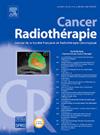Comprehensive analysis of uveal mucosa-associated lymphoid tissue lymphomas: Epidemiological insights and radiotherapy utilization from the Surveillance, Epidemiology and End Results database
IF 1.4
4区 医学
Q4 ONCOLOGY
引用次数: 0
Abstract
Purpose
Uveal mucosa-associated lymphoid tissue lymphomas are rare, indolent ocular tumours affecting the choroid, ciliary body, or iris. Due to their rarity, demographic and treatment data remain limited.
Materials and methods
This retrospective study analysed uveal mucosa-associated lymphoid tissue lymphoma cases diagnosed between 2000 and 2021 from the Surveillance, Epidemiology and End Results (SEER) database across 17 registries.
Results
Twenty-seven cases of uveal mucosa-associated lymphoid tissue lymphoma were identified from the SEER database (2000–2021), representing 0.12 % of 22,246 extra-nodal MALT lymphomas, with an age-adjusted incidence of 0.014 per 1,000,000 person-years. Median age was 65–69 years, with a near-equal sex ratio and 74 % of patients being Caucasian. Most cases were stage I (74.1 %) at diagnosis. Radiotherapy alone was the most common treatment (55.6 %). At a median follow-up of 69 months, the 5-year overall survival rate was 78.9 %, with no relapses or lymphoma-related deaths, yielding 100 % cancer-specific and relapse-free survival. Radiotherapy proved highly effective, supporting its role as a primary treatment.
Conclusion
This is the largest analysis to date, highlighting the excellent prognosis and suggesting potential for radiotherapy dose reduction to lower long-term toxicity.
葡萄膜粘膜相关淋巴组织淋巴瘤的综合分析:来自监测、流行病学和最终结果数据库的流行病学见解和放疗利用
目的:葡萄膜黏膜相关淋巴组织淋巴瘤是一种少见的影响脉络膜、睫状体或虹膜的惰性眼部肿瘤。由于罕见,人口统计和治疗数据仍然有限。材料和方法本回顾性研究分析了来自17个注册中心的监测、流行病学和最终结果(SEER)数据库中2000年至2021年间诊断的葡萄膜粘膜相关淋巴组织淋巴瘤病例。结果从SEER数据库(2000-2021)中鉴定出27例葡萄膜粘膜相关淋巴组织淋巴瘤,占22246例结外MALT淋巴瘤的0.12%,年龄调整后的发病率为0.014 / 1,000,000人年。中位年龄为65-69岁,性别比例接近相等,74%的患者为白种人。大多数病例在诊断时为I期(74.1%)。单纯放疗是最常见的治疗方法(55.6%)。在69个月的中位随访中,5年总生存率为78.9%,无复发或淋巴瘤相关死亡,达到100%的癌症特异性和无复发生存率。放射治疗被证明是非常有效的,支持其作为主要治疗的作用。结论这是迄今为止最大规模的分析,强调了良好的预后,并提示减少放疗剂量以降低长期毒性的潜力。
本文章由计算机程序翻译,如有差异,请以英文原文为准。
求助全文
约1分钟内获得全文
求助全文
来源期刊

Cancer Radiotherapie
医学-核医学
CiteScore
2.20
自引率
23.10%
发文量
129
审稿时长
63 days
期刊介绍:
Cancer/radiothérapie se veut d''abord et avant tout un organe francophone de publication des travaux de recherche en radiothérapie. La revue a pour objectif de diffuser les informations majeures sur les travaux de recherche en cancérologie et tout ce qui touche de près ou de loin au traitement du cancer par les radiations : technologie, radiophysique, radiobiologie et radiothérapie clinique.
 求助内容:
求助内容: 应助结果提醒方式:
应助结果提醒方式:


